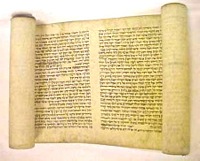Difference between revisions of "Scroll"
(Created page with 'File:lighterstill.jpgright|frame ==Origin== [http://nordan.daynal.org/wiki/index.php?title=English#ca._1100-1500_.09THE_MIDDLE_ENGLISH_PERIOD Middle E...') |
m (Text replacement - "http://" to "https://") |
||
| (One intermediate revision by the same user not shown) | |||
| Line 2: | Line 2: | ||
==Origin== | ==Origin== | ||
| − | [ | + | [https://nordan.daynal.org/wiki/index.php?title=English#ca._1100-1500_.09THE_MIDDLE_ENGLISH_PERIOD Middle English] ''scrowle'', blend of ''rolle'' roll and ''scrowe'' scrap, scroll (from Anglo-French ''escrowe'', of Germanic origin; akin to Middle Dutch ''schrode'' piece cut off, Old High German ''scrōt'') |
| − | *[ | + | *[https://en.wikipedia.org/wiki/15th_century 15th Century] |
==Definitions== | ==Definitions== | ||
*1a : a roll (as of [[papyrus]], leather, or parchment) for [[writing]] a [[document]] | *1a : a roll (as of [[papyrus]], leather, or parchment) for [[writing]] a [[document]] | ||
| Line 12: | Line 12: | ||
:b : the curved head of a bowed stringed musical instrument | :b : the curved head of a bowed stringed musical instrument | ||
==Description== | ==Description== | ||
| − | A '''scroll''' is usually divided up into pages, which are sometimes separate sheets of [[papyrus]] or parchment glued together at the edges, or may be marked divisions of a continuous roll of [[writing]] material. The scroll is usually unrolled so that one page is [[exposed]] at a time, for writing or [[reading]], with the remaining pages rolled up to the left and right of the visible page. It is unrolled from side to side, and the [[text]] is written in lines from the top to the bottom of the page. Depending on the [[language]], the letters may be written left to right, right to left, or alternating in direction ([ | + | A '''scroll''' is usually divided up into pages, which are sometimes separate sheets of [[papyrus]] or parchment glued together at the edges, or may be marked divisions of a continuous roll of [[writing]] material. The scroll is usually unrolled so that one page is [[exposed]] at a time, for writing or [[reading]], with the remaining pages rolled up to the left and right of the visible page. It is unrolled from side to side, and the [[text]] is written in lines from the top to the bottom of the page. Depending on the [[language]], the letters may be written left to right, right to left, or alternating in direction ([https://en.wikipedia.org/wiki/Boustrophedon boustrophedon]). |
Some scrolls are simply rolled up pages; others may have wooden rollers on each end: Torah scrolls have rather elaborate rollers befitting their [[ceremonial]] function. | Some scrolls are simply rolled up pages; others may have wooden rollers on each end: Torah scrolls have rather elaborate rollers befitting their [[ceremonial]] function. | ||
| − | The scroll has now largely been replaced by the [ | + | The scroll has now largely been replaced by the [https://en.wikipedia.org/wiki/Codex codex], a process which started almost as soon as the codex was invented. For example, in Egypt by the fifth century, the codex outnumbered the scroll or roll by ten to one based on surviving examples, and by the sixth century the scroll had almost vanished from use as a vehicle for [[literature]]. |
[[Category: Languages and Literature]] | [[Category: Languages and Literature]] | ||
Latest revision as of 02:37, 13 December 2020
Origin
Middle English scrowle, blend of rolle roll and scrowe scrap, scroll (from Anglo-French escrowe, of Germanic origin; akin to Middle Dutch schrode piece cut off, Old High German scrōt)
Definitions
- b archaic : a written message
- c : roster, list
- d : a riband with rolled ends often inscribed with a motto
- 2a : something resembling a scroll in shape; especially : a spiral or convoluted form in ornamental design derived from the curves of a loosely or partly rolled parchment scroll
- b : the curved head of a bowed stringed musical instrument
Description
A scroll is usually divided up into pages, which are sometimes separate sheets of papyrus or parchment glued together at the edges, or may be marked divisions of a continuous roll of writing material. The scroll is usually unrolled so that one page is exposed at a time, for writing or reading, with the remaining pages rolled up to the left and right of the visible page. It is unrolled from side to side, and the text is written in lines from the top to the bottom of the page. Depending on the language, the letters may be written left to right, right to left, or alternating in direction (boustrophedon).
Some scrolls are simply rolled up pages; others may have wooden rollers on each end: Torah scrolls have rather elaborate rollers befitting their ceremonial function.
The scroll has now largely been replaced by the codex, a process which started almost as soon as the codex was invented. For example, in Egypt by the fifth century, the codex outnumbered the scroll or roll by ten to one based on surviving examples, and by the sixth century the scroll had almost vanished from use as a vehicle for literature.
